How to make Water Kefir! A happy, bubbly, fruit-infused sparkling water, that is packed full of healthy probiotics that will energize the body and support the gut.
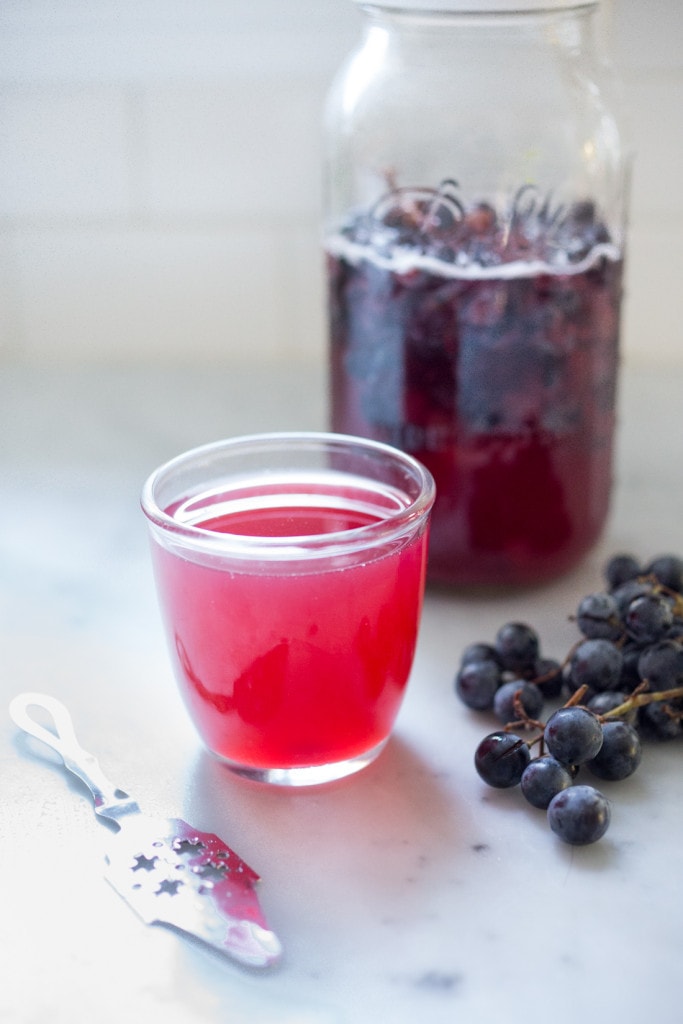
I want to introduce you to a happy, bubbly probiotic drink called water kefir!
This delicious, effervescent, fruit-infused water si full of healthy probiotics that support a healthy, diverse microbiome, clears the skin, and energizes the whole body. It’s similar to kombucha but without the caffeine!
The best part is that it is easy to make at home! I hadn’t heard of water kefir until a friend of mine, Bee (from H is For Love), introduced it to me a few years ago, and since then, I’ve been crazy, head-over-heels in love with it. We’ve been making batches and batches of this refreshing, healthy beverage all summer long.
But First, What is Water kefir?
- Fermented, fruit-infused water, similar to kombucha in that it’s slightly fermented and effervescent-but water kefir is fermented with live water kefir grains, which are a yeast-bacteria that believed to originate from the pad of a cactus plant in Mexico.
- Water kefir is completely different from Milk kefir. Not only is this a dairy-free probiotic, it’s gluten-free.
- Water Kefir Grains are “fed” with sugar and actually metabolize (consume) the sugar, making the final drink very low in sugar!
Watch How to Make Water Kefir
How long does it take to make kefir water?
It takes about 3-4 days to make Kefir Water, with only 15 minutes of hands-on time!
Water Kefir Ingredients
- Water Kefir Grains -This is the starter culture that ferments the water. Soft and gelatinous “grains” (a combination of yeast and bacteria) believed to originate from Mexico where they were found attached to the Ountia cactus (prickly pear) thriving from the cactus’s sugary water. Purchase Water kefir grains in the refrigerated section of your health food store, or purchase online, and read the package directions to fully activate them before starting! This may take a week- or may come already activated.
- Sugar – Types of sugar include organic cane sugar, coconut sugar, jaggery, molasses, sucanat, brown sugar, raw sugar, turbinado, piloncillo (evaporated sugar cane juice in a cone-shape found in Mexican markets). White sugar is very mineral deficient so I try not use it- or only in a pinch.
- Fruit – fresh fruit and berries are ideal here. Juicy ripe stone fruits ( plums, peaches, nectarines, cherries, etc.) fresh berries (strawberries, huckleberries, blackberries, blueberries, etc.) Pineapple, apples, pears, or Frozen fruit, or fruit juice will work too.
- Water- Tap water or well water is generally best when making water kefir- or use “still” mineral water. Hard water is better than soft water here! Filtered water, reverse osmosis water, or soft water or highly chlorinated water can actually inhibit fermentation. Distilled water tends to lack minerals that feed the kefir grains.
- Lemon Slices – to prevent kahm yeast.
- Unsufulerd Prunes- optional, to boost fermentation- or sub-dried figs, unsulfered apricots, or other dried fruit.
- 2-quart mason jars ( you will need 2-3 jars)
- A strainer
- A kitchen towel
How to make Water Kefir
- STEP ONE: Fill two, 2-quart mason jars to the halfway mark.
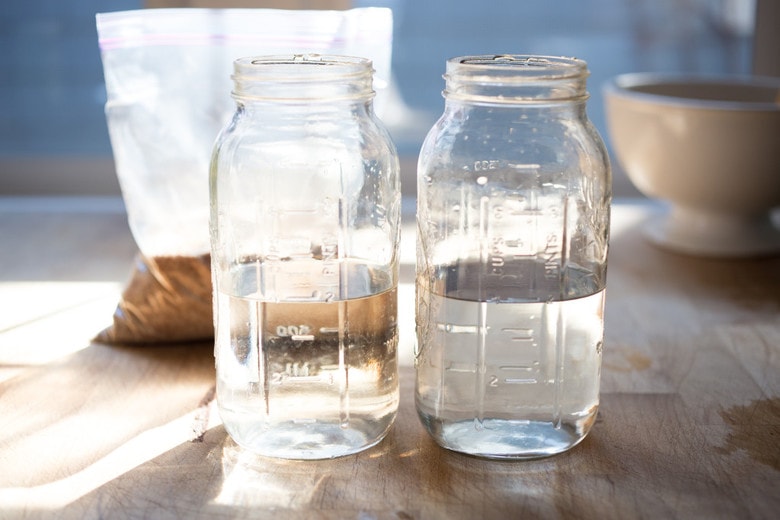
STEP TWO. To the water, mix in ¼ cup of organic cane sugar into each jar. I highly recommend making the “sugar mixture” in the recipe notes which contains more minerals (than white sugar) which keep the grains happy and help with fermentation.
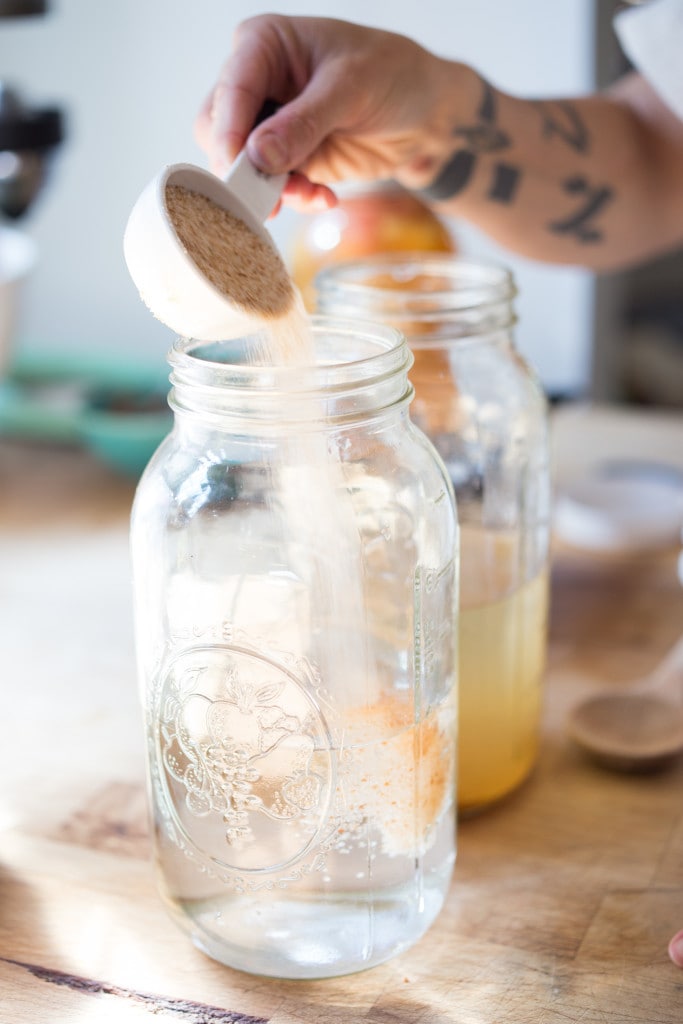
Now before you start thinking (like I did) that there is so much sugar in this, and how it must be so high in calories, remember, the kefir grains metabolize the sugar, which means they basically “eat” the sugar, (this is what feeds them) taking it out of the water. Once it’s done doing its thing, the water is only very mildly sweet, which I find completely and utterly fascinating!
Where does the sugar go?
From Yeemos: “Kefir grains are an amazing symbiotic matrix of bacteria and yeast that work together to feed off the natural sugars (and sometimes proteins and fats too, especially in the case of milk kefir) found present in the sugar-water and dried fruits. The yeast and bacteria cooperate, making the nutrients that are inaccessible to one digested into accessible nutrients for the other. Yeasts break down the simple sugars like glucose and fructose, turning them into ethanol and acetic acid. Lactic and acid-producing bacteria (such as lactobacilli) convert sugars (such as sucrose) and complex carbohydrates (starches, etc) into simpler sugars and lactic acid. Lactic and acetic acids naturally preserve as well as stave off harmful foreign bacteria. The result is a drink that has had much of the sugar converted to simpler sugars, lactic and acetic acids, carbon dioxide and ethanol. It also contains millions of probiotics and is more nutritious in some regards because of the more bio-available and digestible nutrients from the sugars and dried fruits including an increase in vitamin C and many B vitamins.” From Yemoos
Stir the sugar into the water with a wood spoon until dissolved.
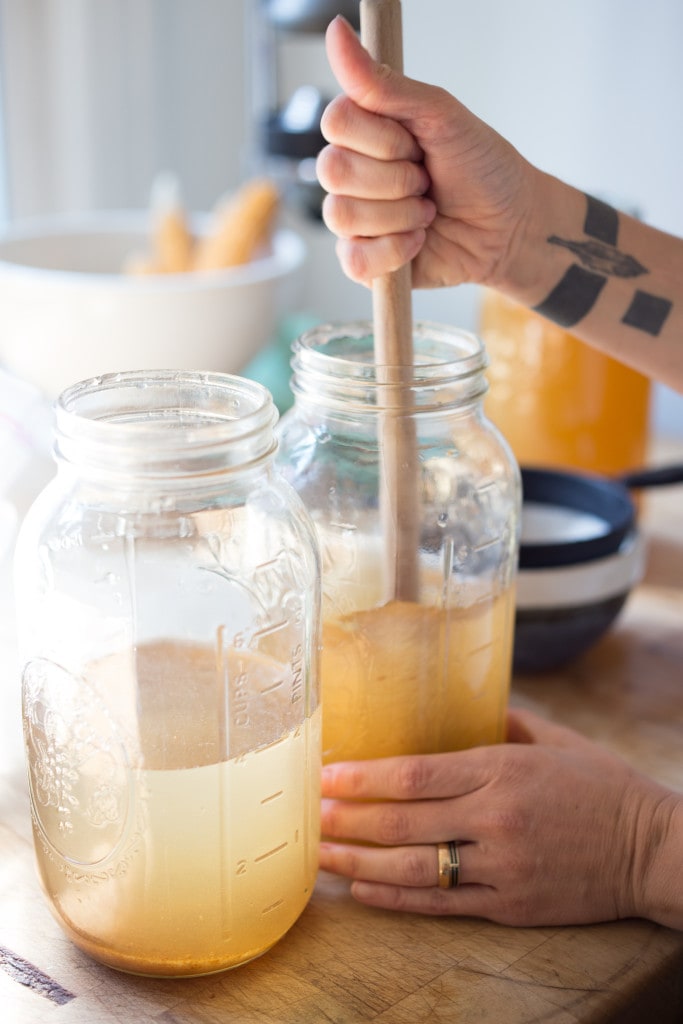
STEP THREE: Add 1/4 cup water kefir grains to each jar. Gently stir.
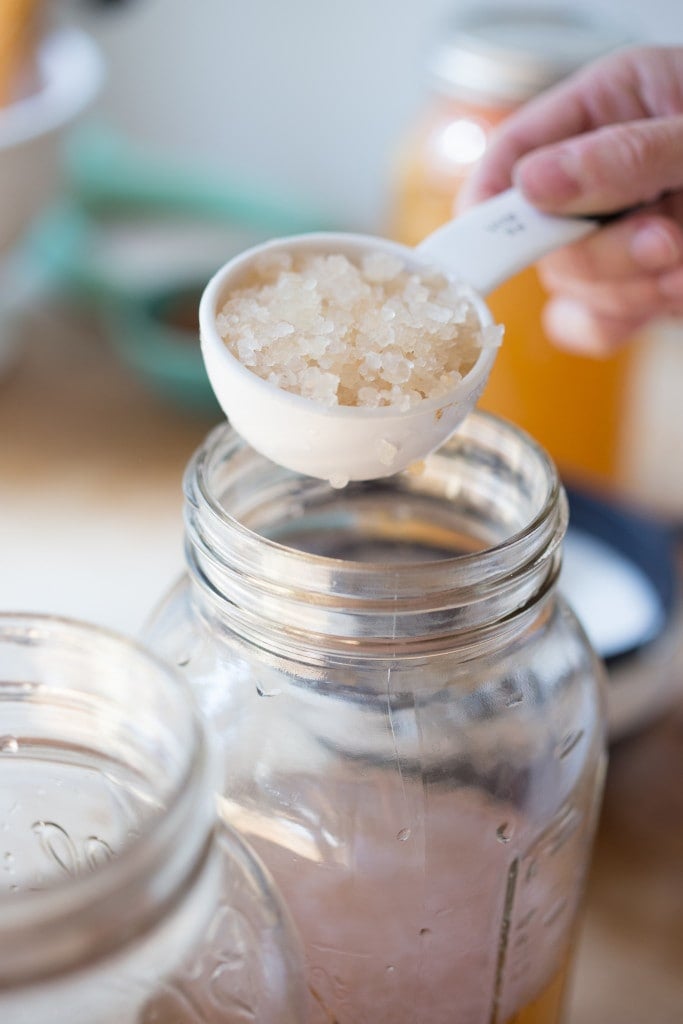
STEP FOUR: Add a big slice of lemon to each jar. Now if you are allergic to lemons, sub orange, lime or even grapefruit. The acidity here helps prevent the growth of Kahm yeast – a harmless yeast but one that could affect the taste.
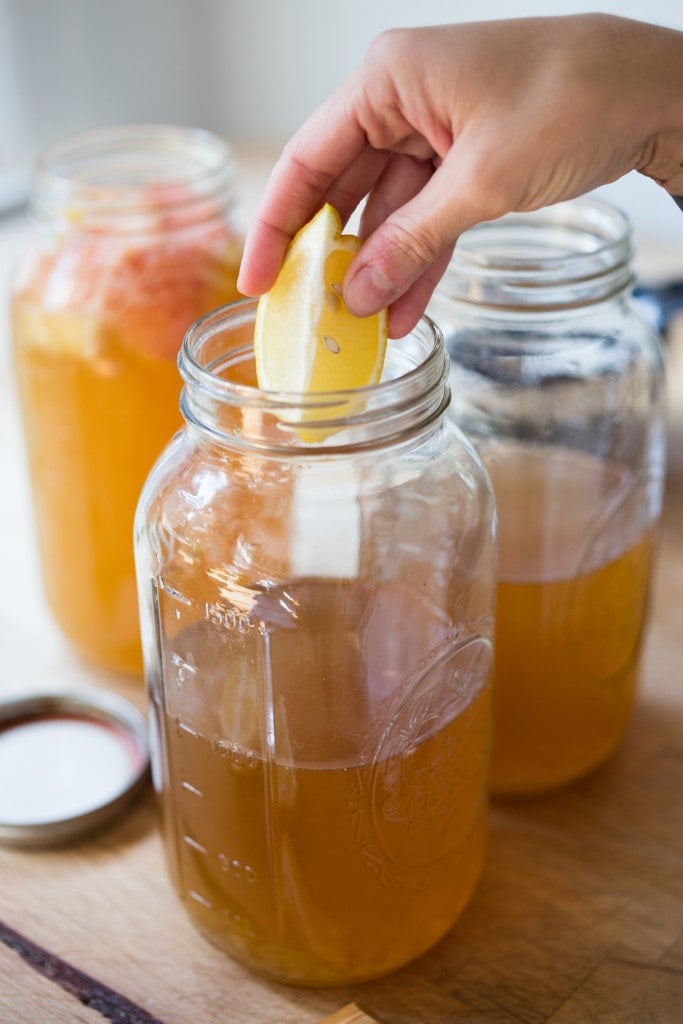
STEP FIVE: Add one prune to each jar. These seem to also boost fermentation. They are not imperative, but definitely add if you have them on hand. A dried fig, or a few raisins would work too.
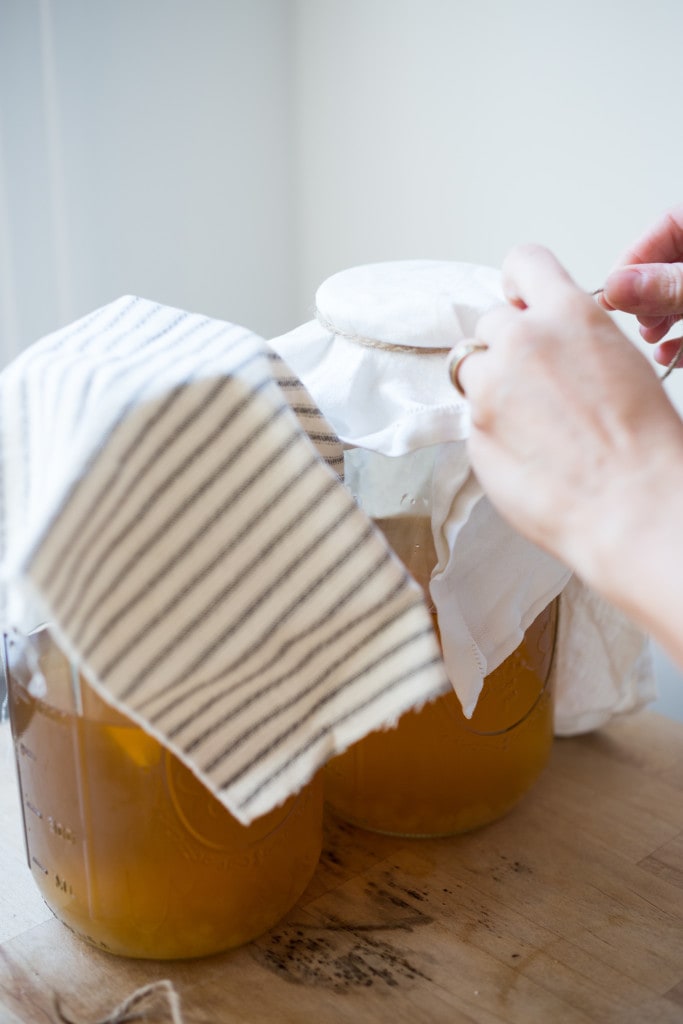
STEP SIX: Cover with a thin kitchen towel. It needs to breathe, but you want to prevent little fruit flies from getting in and seal it with twine or a rubber band. You could also top it with a coffee filter.
STEP SEVEN: The First Ferment. Let the jars sit on the kitchen counter at room temperature for 2-3 days. Two days if it’s warm out (in the summer), 3-4 days if it’s cold. Right now in fall, I’m leaving it out for 3 days.
Check for sweetness. After 2 or 3 days your kefir water should have fermented slightly – and you can check this by tasting it. If it tastes very sweet, then the sugar has not been metabolized and you need to ferment it longer. The longer it goes, the tangier it will taste and the less sweet it will get. You want it to taste balanced- just subtly sweet with a little bit of tangy. Find your own balance. If you taste no tanginess, it may not have fermented, a sign the kefir grains may not be healthy, active or alive.
TIP: Tangy or sour flavors tell you it has fermented. If it is not getting tangy or sour after 3-4 days, then your kefir grains may not be alive or active.
STEP EIGHT: Create your flavor. Place 1 – 1 1/2 cups fresh fruit in one clean 2-quart jar– like fresh berries, peaches, apricots, pineapple, plums, concord grapes, apples or pears. You can also add fresh herbs. Then strain both jars of the fermenting kefir into the third clean jar with the fresh fruit in it, straining out the kefir grains (set these aside) filling the jar to a ½ inch from the top. (Save the extra fermented water to store the grains in and place them in the fridge with 1 tablespoon sugar. Add more water to cover.)
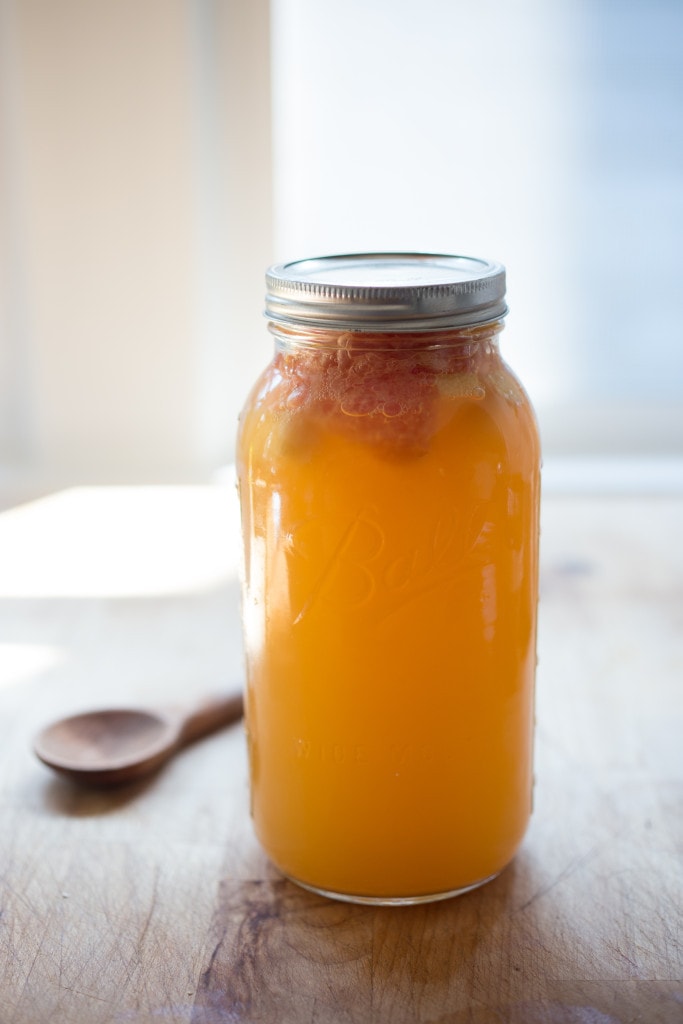
STEP NINE: The Second ferment. Once the fruit is added, cover tightly with a lid, and leave on the counter for another 24 hours. Your kefir should start bubbling. During the 2nd Ferment, the water kefir is creating gas and building pressure, which you want it to do – this makes it nice and bubbly, but with the metal lids, you must let out some of the pressure, “burping it” every 6-12 hours or so (depending on the temperature in your kitchen) so the lid doesn’t explode open (yes this happened to me). With a plastic lid, it stays on fine, and the air can escape. If using a metal lid, just screw the top on loosely until you feel the first resistance- this will allow some air to escape.
WARNING: These metal lids like in the photos above, have pros and cons. They allow pressure to build up, with their tight seal, creating bubbly effervescent kefir, but they can explode if the pressure is not released occasionally. They must be burped! If you need to leave your home and are worried about the jar exploding, simply loosen the lid while you are gone. Place the jar over a bowl to collect any runoff.
Plastic lids are “self-burping”, which if you are away from home for over 8 hours, I would recommend using. The downside is the plastic lids do not let the pressure build quite enough in my opinion so kefir is not quite as bubbly. Sometimes I switch between both, depending on if I am planning to be gone.
STEP NINE: After 24 hours, the fruit will float the surface and it’s time to refrigerate. You can strain the fruit, eat the fruit ( it won’t hurt you) or keep it in the water to infuse longer – I generally just leave it in, and strain it as I pour into a glass. Up to you.
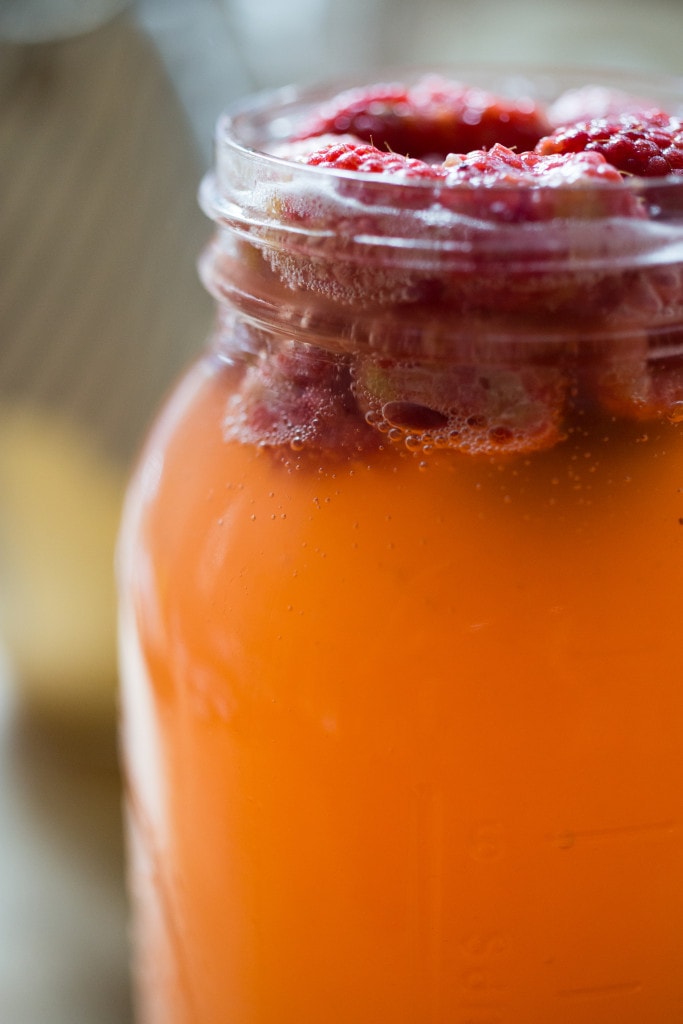
Troubleshooting Water Kefir:
- If you see a white yeast on top of your second ferment, it is most likely kahm yeast. Kahm yeast is harmless but can affect the taste in an unpleasant way.
- If you have Kahm yeast, make sure to rinse your kefir grains in pure clean water before storing in a clean jar with no soap residue. Cover with clean water and feed. This should hopefully prevent it from coming again.
- Make sure to add citrus to your kefir water, to help prevent Kahm yeast.
- Leave less headroom at the top of the jar for oxygen to get in, during the second fermentation (1/2 inch). Rinse your fruit before using, as this can also introduce the yeast.
- Sometimes Kahm yeast can grow when the environment’s temperature is too warm.
- If water kefir is not bubbling or not fermenting, it can be due to a lack of minerals. Use the mineralized sugar mixture, or try adding a pinch of sea salt.
How to Maintain & Grow Your Water Kefir Grains
- The kefir grains that you strained out earlier can be stored in a smaller jar, in the fridge in water or the extra water kefir, you will have after you merge the two jars into one. These grains will need to be fed weekly.
- When refrigerated, you want to feed the grains (with sugar) at least once a week, to keep them healthy and alive. They are happiest when they are actually making water kefir, so I just make one jar a week.
- If you want to make kefir water more often (or grow the grains faster so you can give some away) you can leave them out on the counter, feeding every two days.
- Feed 1 cup kefir grains with 1 tablespoon sugar, in 2 cups water, in the fridge once weekly. Feel free to change out the water every 2-3 weeks.
- The colder they are kept, the slower they will metabolize the sugar. The warmer they are, the faster they will metabolize the sugar- and will need to be fed more often.
- You can tell if the grains are “hungry” by tasting the liquid- if it is not sweet, but tangier, they are probably ready to be fed. If the water is sweet, they are not hungry and do not need to be fed.
- If the sugary water never gets tangy or sour (indicating fermentation) then your grains may likely not be alive or active.
Water kefir Flavors and Variations
Once you get the hang of making water kefir- the variations are truly endless! I usually start with what is in season- seasonal fruits and berries and add from there. You can also add herbs, spices and even chia seeds!
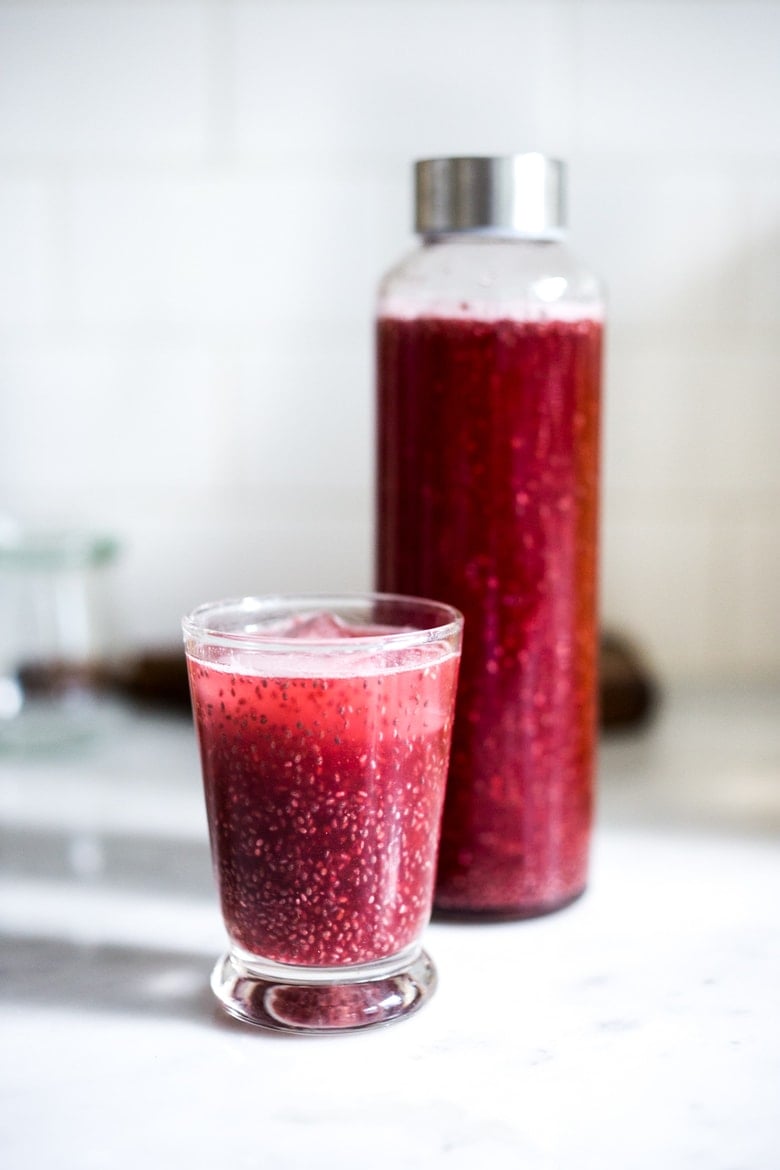
There are so many versions to make….. the possibilities are endless! Here above is Strawberry-Raspberry Water Kefir with Chia Seeds– energizing and refreshing!
Here below is peach ginger.
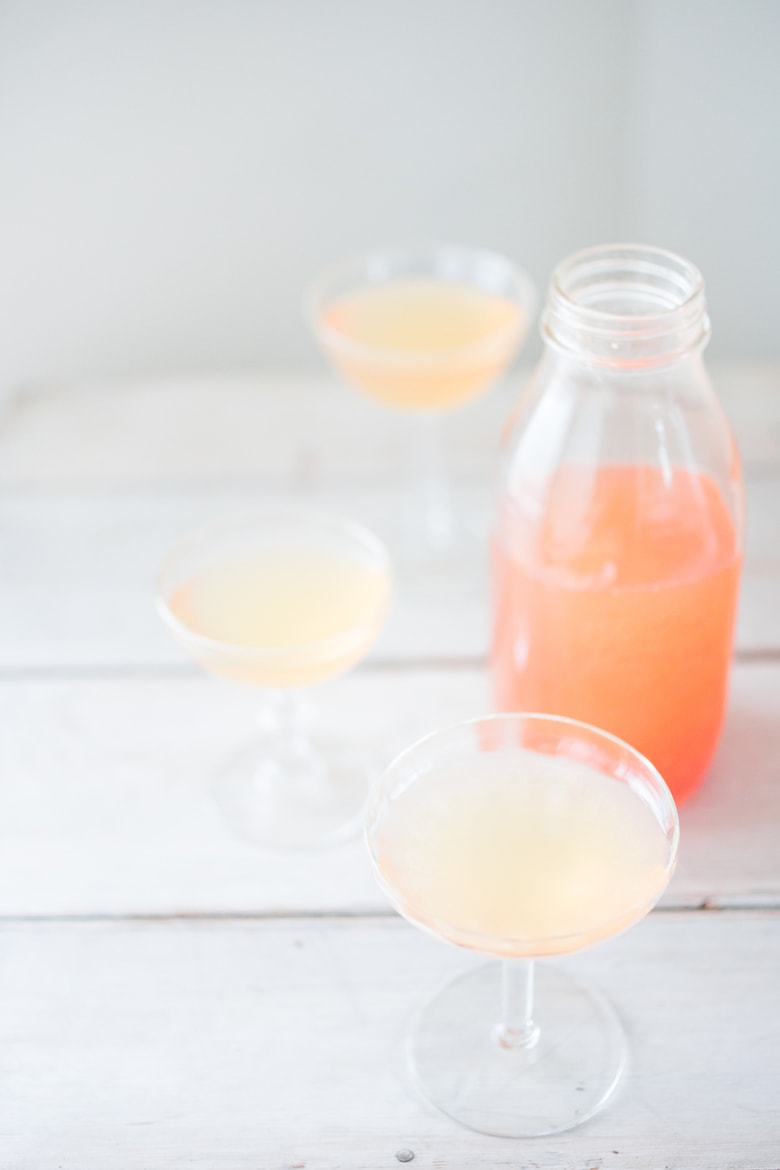
And here below is a Plum-Ginger Water Kefir with shiso leaves.
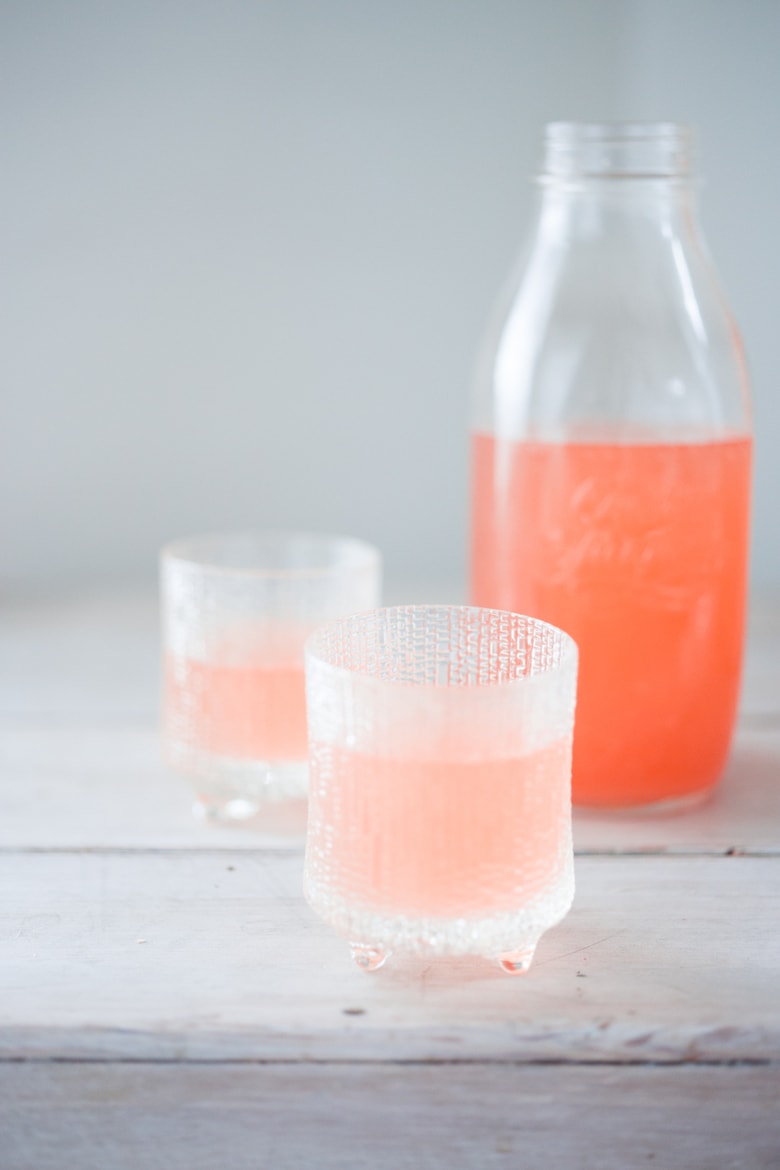
Here is Strawberry Basil Water Kefir!
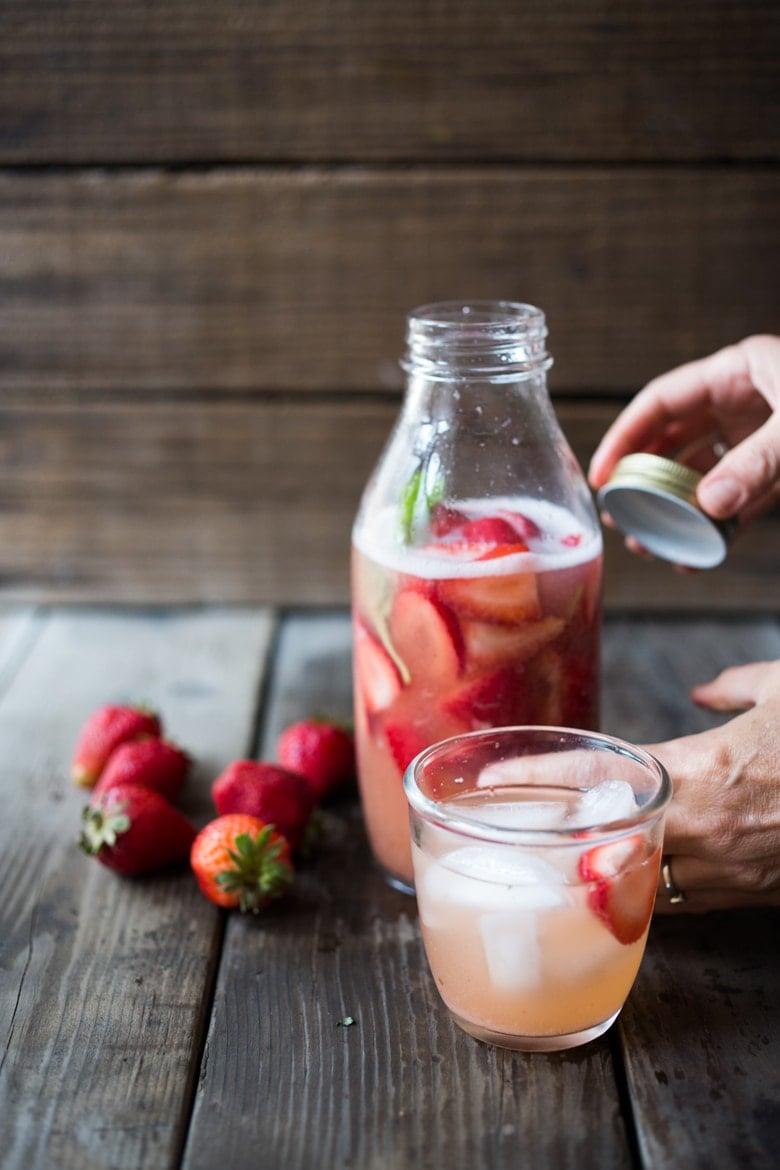
You’ll love how refreshing, tangy, fruity and delicious this is- so much better than a soda stream- with many more minerals, nutrients and probiotics.
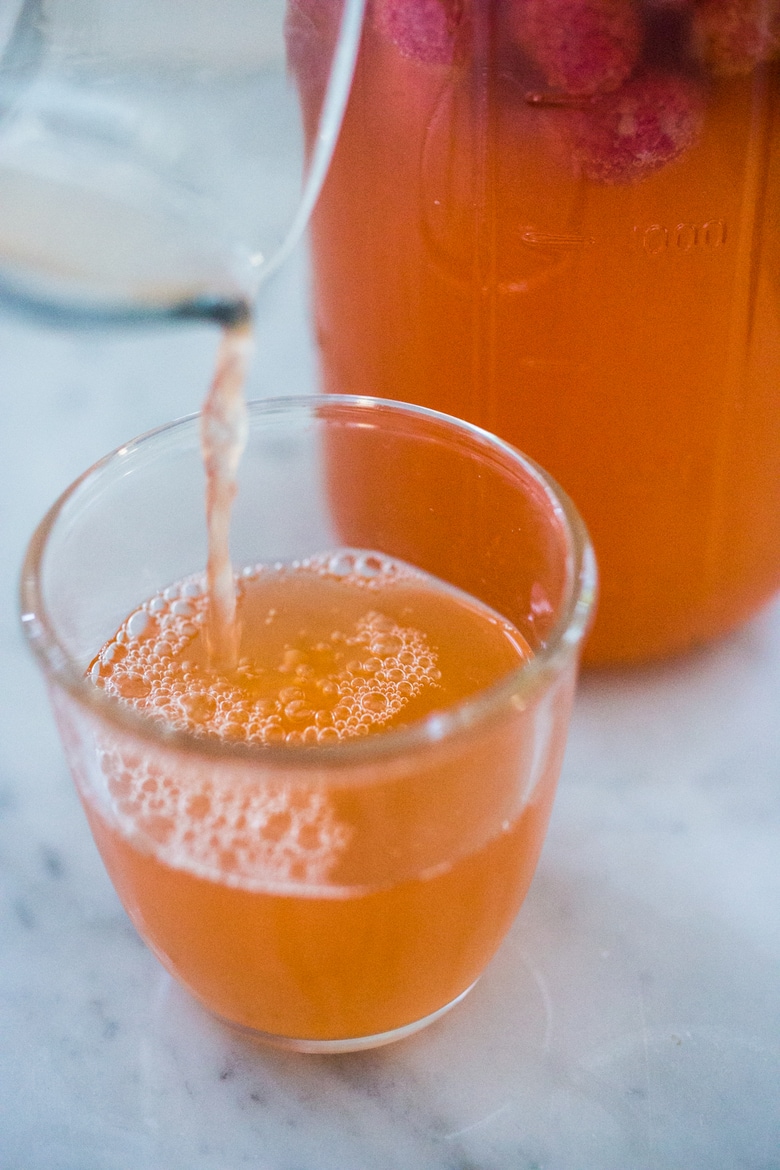
The possibilities are endless! Get some water kefir grains and give it a try!
Health Benefits of Water Kefir
More Fermented Probiotic Recipes
Water Kefir Faqs
Water kefir is full of healthy probiotics that increase the diversity of good bacteria in our gut, the foundation of a healthy immune system. It’s low in sugar, and full of nutrients from fresh fruit.
Water kefir is slightly fermented which can produce trace amounts of naturally occurring alcohol. This is typically around .02 % which equates to roughly ¼ teaspoon in a 12-ounce glass.
If your gut is healthy and diverse, yes! If you are new to consuming fermented foods, or have gut dysbiosis you may need to start off slowly and gently introduce it. Start with a few sips, and see how it feels, if ok, then try a quarter cup, see how you feel, and add from there. If you experience a lot of gas, bloating, back way down, and just take a sip or two daily until these symptoms go away.
Both kombucha and water kefir have health benefits- both contain healthy strains of probiotics. Kombucha contains caffeine from tea and aids with digestion. Water kefir is caffeine-free and typically contains more strains of good bacteria, though some believe not as potent- which may be beneficial for those new to consuming fermented foods- because they are gentler on the belly.
Enjoy the process and please share your flavors and adaptions in the comments below. ❤️
More from Feasting at Home
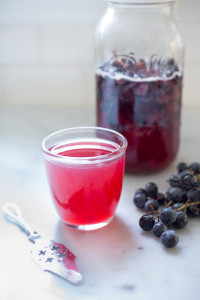
How to make Water Kefir
- Prep Time: 5 mins
- Cook Time: 72 hours
- Total Time: 72 hours 5 mins
- Yield: 8 cups
- Category: Drinks
- Method: fermented
- Cuisine: American
Description
A simple guide to making Water Kefir-a refreshing probiotic fruit-infused drink made with water kefir grains (cactus grains) that is bubbly, effervescent and so healthy!
Ingredients
- 1/2 cup alive water kefir grains
- 8 cups tap or well water- divided
- 1/2 cup sugar (divided) organic cane sugar, coconut sugar, or a ***mixture-see notes. ( FYI this will be metabolized or consumed by the kefir grains, so it will NOT end up in the finished drink!)
- 2 lemon wedges (optional)
- 2 prunes (or dates, or or dried fruit) optional
- ——-
- 1 –2 cups fresh fruit- berries, stonefruit (peaches, plums, nectarines), apples, pears, mango, pineapple, etc.
Optional Additions- fresh ginger, whole spices, herbs.
Instructions
- Fill two, half-gallon mason jars with 4 cups cool tap water in each.
- Add ¼ cup sugar in each, stirring to mostly dissolve. ( Feel free to make sugar mixture first)
- Add ¼ cup kefir grains to each jar.
- Add ¼ cup kefir water to each jar (optional–you can obviously only do this after your first batch of kefir, so just leave it out for the first batch.)
- Add ¼ of a lemon wedge to each jar.
- Add 1 prune to each jar.
- Cover both jars with a thin kitchen cloth and leave on the counter for 2-4 days. 2 days if warm out, 3-4 days if cold. This 2-4 day time period allows the grains “to eat” the sugar, so most of the sugar will actually be metabolized, and not end up in the drink itself. You want the water to get the point where it is just slightly sweet, and nicely tangy. So taste it before moving to the next step. If it tastes very sweet, it’s not ready. When it’s cold this takes longer.
- After 2-3 days the kefir will have fermented slightly, taste tangy or lightly sour, but there is one more step which gives it flavor and makes it effervescent and bubbly.
- FLAVOR: Get your third jar ready and place 1- 1 1/2 cups fresh, ripe fruit in it– like fresh berries, peaches, mango, pineapple, plums, concord grapes, apples, pears – I muddle them up a bit to release their juices. Add a few thin slices of ginger, or whole spices if you wish. Or add 1 cup fruit juice – especially nice in winter when fresh fruit is limited.
- Strain both jars of the fermenting kefir water into the third clean jar with the fresh fruit in it, straining out the kefir grains ( set them aside), tossing the lemon and prunes, filling the clean jar (with the fruit in it) to a 1/2 inch from the top. Then cover tightly with a lid, and leave this on the counter another 24 hours, allowing pressure to build up yet, burping the lids (releasing the pressure), every 8-12 hours or so, more often especially if warm. Keep in mind, not burping may cause the jar to explode. If you must leave them for longer, either loosen the lid and place jar in a bowl to collect runoff, or place the jar in the fridge, to slow the fermentation down, and continue fermenting on the counter when you have more time.
- WARNING: These metal lids like in the photos above, have pros and cons. They allow pressure to build up, with their tight seal, creating bubbly effervescent kefir, but they can explode if the pressure is not released occasionally. Plastic lids are “self-burping”, which if you are away from home for over 8 hours, I would recommend using. The downside is the plastic lids do not let the pressure build quite enough in my opinion so kefir is not quite as bubbly. Sometimes I switch between both, depending on if I am planning to be gone.
- To reiterate- During the 2nd fermentation phase, the water kefir is creating gas and building pressure, which you want it to do – this makes it nice and bubbly, but with the metal lids, you must let out some of the pressure, “burping it” every 6-12 hours or so, so the lid doesn’t bend or blast open (yes this happened to me). With a plastic lid, it stays on fine, it self burps, but it’s less bubbly.
- After 24 hours, the fruit will float to the surface and it’s time to refrigerate it. Burp it, place it in the fridge, lid tight. Once it’s chilled, give it a try. You can strain this and put it in a different pourable container, or just strain as you pour, leaving the fruit in for maximum infusion. Up to you.
- The kefir grains that you strained out earlier should be stored in a smaller jar, in the extra kefir water you will have after you merge the two jars into one. You can refrigerate them and feed with a tablespoon of sugar, every week –or if trying to grow more grains to give away, store the jar on the counter, feeding every couple of days. They grow faster at room temp, and grow slower in the fridge. They are happiest when they are actually making water kefir, so I usually make a jar a week. See notes.
Notes
Sugar Mixture: (optional, but highly nutritious to you kefir grains)
- 1 cup cane sugar
- 1/2 cup coconut sugar
- 1/4 teaspoon sea salt
Yes, feel free to halve the recipe.
It is OK to use frozen berries or fruit.
YES, you can get by with two 2-quart mason jars ( instead of 3). Strain one of the kefir jars into a pitcher, temporarily, rinse out the mason jar, add the fruit to this one, and pour in strained kefir water form pitcher and 2nd jar. Get it? 😉
Adding the lemon helps prevents kahm yeast, and the prune really adds flavor and helps with fermentation.
Kahm Yeast: If you see a white yeast on top of your second ferment, it is most likely kahm yeast. It’s harmless but can affect the taste. If you have Kahm yeast, make sure to rinse your kefir grains in pure clean water before storing in a clean jar with no soap residue. Cover with clean water and feed. This should hopefully prevent it from coming again. Make sure to add Citrus to your kefir water. Make sure all jars are clean. Leave less headroom at the top of the jar for oxygen to get in, during the second fermentation. Rinse your fruit before using, this can introduce the yeast. Sometimes it can grow if the environment is too warm.
How to maintain/grow your kefir grains:
The kefir grains that you strained out earlier can be stored in a smaller 8-ounce jar, in the fridge in the extra water kefir you will have after you merge the two jars into one. Add more water to fill and 1 tablespoon sugar.
- When refrigerated, you want to feed the grains at least once a week, to keep them healthy and alive. They are happiest when they are actually making water kefir, so I just make one jar a week.
- If you want to make kefir water more often (or grow the grains faster so you can give some away) you can leave them out on the counter, feeding every two days.
- Feed 1 cup kefir grains with 1 tablespoon sugar, in 2 cups water, in the fridge once weekly. Feel free to change out the water every 2-3 weeks.
- The colder they are kept, the slower they will metabolize the sugar. The warmer they are, the faster they will metabolize the sugar- and will need to be fed more often.
- You can tell if the grains are “hungry” by tasting the liquid- if it is not sweet, but tangier, they are probably ready to be fed. If the water is sweet, they are not hungry and do not need to be fed.
Nutrition
- Serving Size: 1 cup
- Calories: 38
- Sugar: 8.5 g
- Sodium: 9.7 mg
- Fat: 0.1 g
- Saturated Fat: 0 g
- Carbohydrates: 9.7 g
- Fiber: 1 g
- Protein: 0.2 g
- Cholesterol: 0 mg
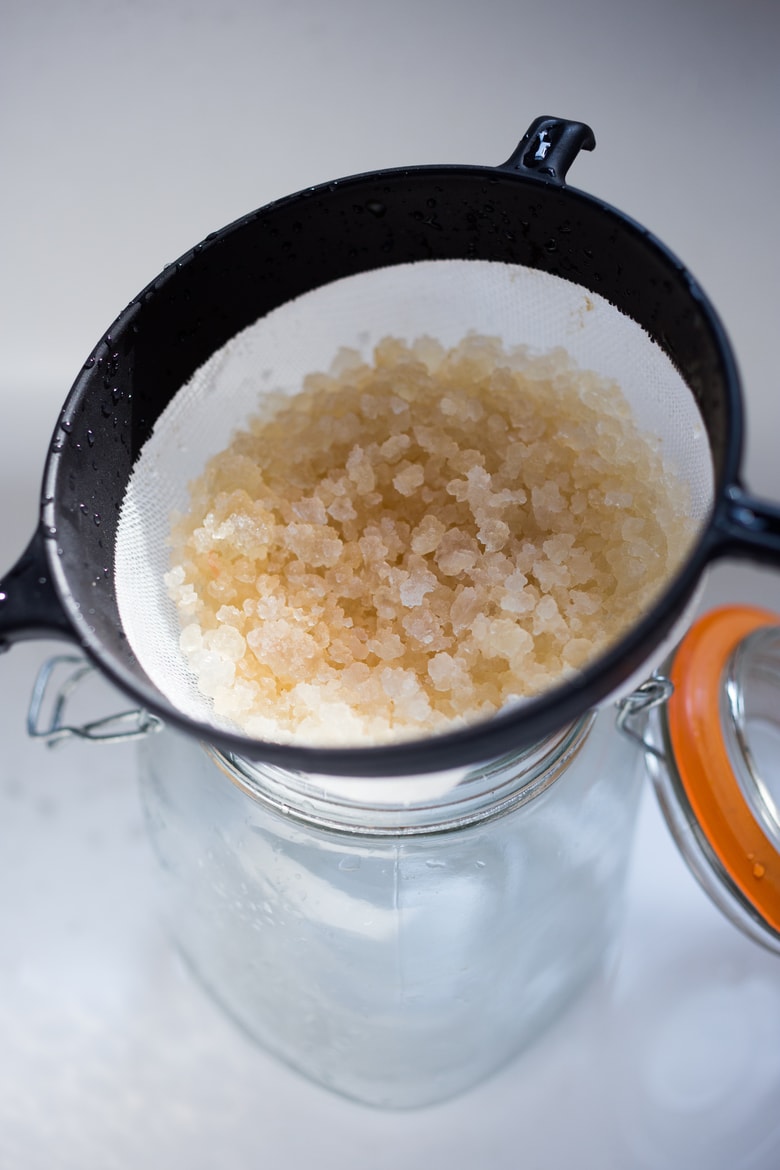
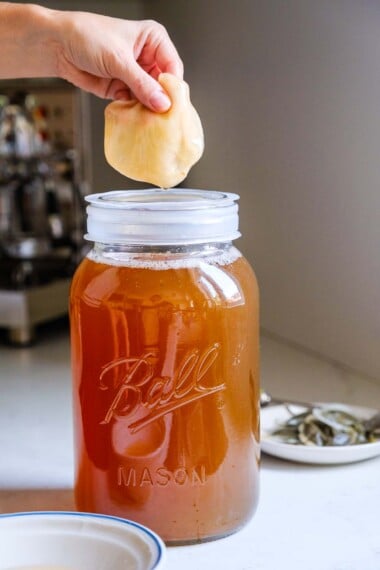
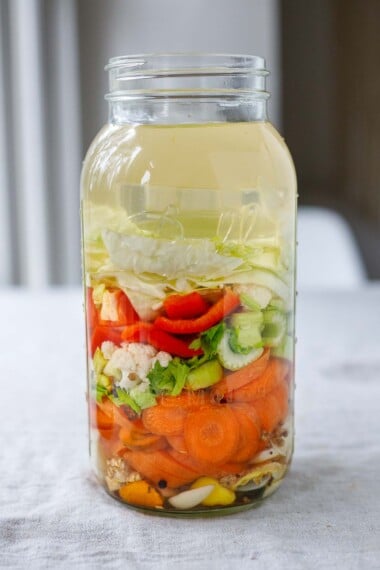
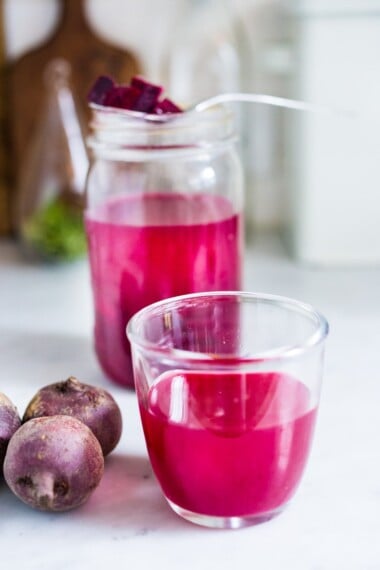
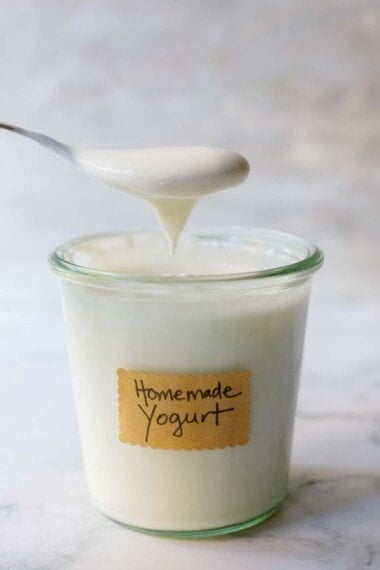
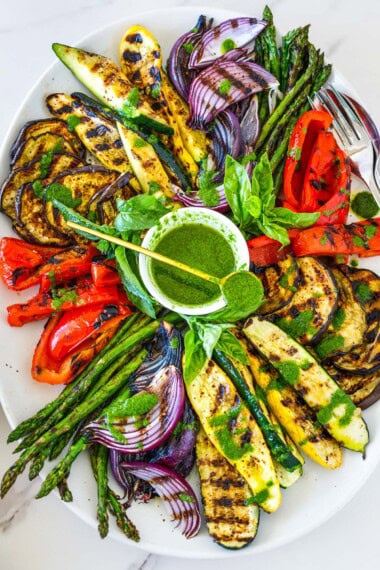



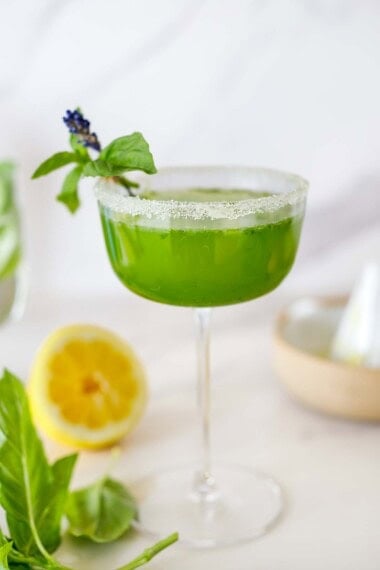
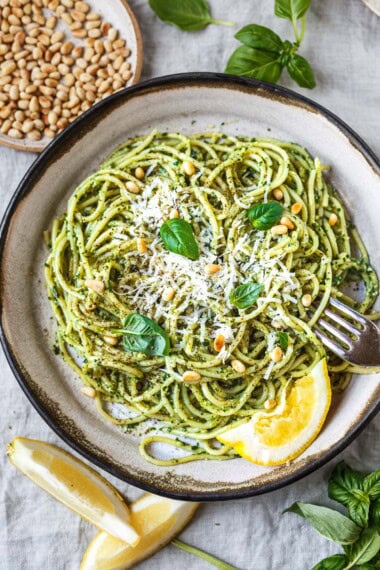
Hi I’m late to this thread, but am having increasing difficulty finding my fave probiotic drinks ready made so want to try your DIY! . Can you provide a link for the specific plastic lids ? I cannot find “ self burping “ thx !
Sure here you go! Self Burping Lids
Hi Sylvia,
Do you use organic fruits?
Thanks.
Yes, I try to. 😉
Thanks for a great tutorial! Also, I adore the little glass cup you have in the first photo (also the same as the one in the photo with the strawberries). May I ask where you got it? Thanks!
Hi. I got kefir grains and started four days ago. I tasted everyday but still tastes sweet, but smells like it’s fermenting. I’m leaving in the mountain and it’s a bit cold here too. Is it okay to leave them until ready or should I start over?
I would leave them until it’s not sweet, but more tangy. If its cold it takes longer. 🙂
Thanks! I made ginger lime kefir with it, and it was so delicious! Taste like my favorite ginger beer! My family loved it too. Thanks again ?
I’m following a Keto diet. ….I know the grains gobble up the sugar on the first fermentation, but what about the 2nd fermentation? I understand obviously it will depend on the fruit added and each batch would be different. …but what eats up the sugar in the 2nd fermentation that might keep it friendly?
Thank you!
Hi Shar, sugar is not added to the second fermentation, only to the first. Before you add the fruit, taste the water kefir, it should not taste sweet, just slightly tangy. If it does taste sweet, leave the grains in longer and let them gobble up more sugar. Add another day, or even two days if the weather is cooler. Hopefully this makes sense. The longer you leave the grains in the first fermentation, the more sugar they will consume, leaving the water, less and less sweet. You can kind of control how sweet you want it to be. 😉
Perfectly made this into my favorite Kevita flavor for 1/10 of the price.
Excellent instructions. But, one question, are the prunes fresh or dried?
Dried!
I’ve been really getting into making water kefir and experimenting with lots of different recipes. Yours is great! Can I ask, why do you do 2 x half-filled jars instead of 1 x filled jar? Does the extra air help with the fermentation?
You know, I had the same question, but that was the way I learned!!! It always turned out that way. Im sure one jar would be fine too. 🙂
This was my question as well! So many large jars. 🙂 Rather than 1 large jar, I think I will use 2 quart jars, simply because I already own them!
That’s a good post. I’ve made it with cranberry-pomegranate juice (tastes like Izze blackberry) and I’ve used grapefruit juice, slightly sweetened with brown sugar. That made a really nice grapefruit soda although my kids didn’t care for it. I’m working on a batch now using strained orange juice (slightly sweetened). I’m aiming for an orange-fanta like taste.
Hi!
I would like to know if it’s mandatory to put a slice of lemon and a date/fig/prune?
I have see a other technique without this. I want to know the difference! 😀
Thank youuu! 🙂
No, neither are mandatory, but both seem to improve the flavor.
Love this thank you! Have done lots of other ferments but not had best success with kefir. Your in depth explanation and lovely pics has worked a treat – much appreciated x
I am new to this and want to make for me, my husband and my daughter. Can you make more than just a quart at a time?
Yes, but note, this is a 2 quart jar.
Has anyone ever used frozen fruit instead of fresh? Berries are pretty much out of season here in New Zealand so frozen berries will be what’s available.
i think that would work just fine!!!
We’ve used frozen blueberries. We enjoyed the drink although the flavour was quite mild. I suspect fresh berries may give us a bigger burst of flavour.
My friend says frozen worked even better, my guess being that the freezing process breaks down the cell walls = easier access to the sugars and nutrients. I am only just getting started so I can’t speak from experience just yet.
Hi Sylvia, my kefir grains were going bananas. I don’t like drinking tap water and wanted to do the best for the grains so used a mixture of reverse osmosis,filter and spring. They stopped growing. They still ferment but don’t multiply. I’m going to try boiled tap water saw you used a tbsp of Himalayan salt. Need to rejuvenate my grains and make them happy again. Any suggestions? Many thanks.
They tend to do this in winter when the weather is cooler. Mine do the same. Its almost like they hibernate!! Are you keeping them on your counter on in the fridge? How often do you make the kefir water?
I’m in Australia and it’s really hot so I’ve been keeping them in the laundry on the counter, no direct sun and when it’s really hot I’ve been sticking them in a cooler with an ice pack. I make the kefir water usually every 48 hours ( 2 – 2 1/2 days). JB
Hummm, something is not right. They should be multiplying….I wonder if you mixed different sugars and yes, sea salt for minerals. Or even added a prune? Does the kefir water you are making taste ok?
Hi thank you for the great info. I just got my kefir grains today. I have them stored in th fridge with sugar water at the moment. Do I put a lid on when storing them? Also when you store the end product in the fridge can you leave it uncovered and how long will it keep in the fridge for? Thanks ?
I lightly cover grains when storing. loose lid. When storing the finished product store with tight lid to preserve the bubbles. 🙂
What are your favorite fruit recipes to put in the jars? Thanks!
I really don’t have a favorite- but usually start with what’s in season. I’m a sucker for ginger so have been doing a combo of apple ginger or pear ginger lately. I love adding berries when in season, and peaches too. But this time of year,it’s more limited. In winter I’ll also add fruit juice too when fresh fruit is sparse, like pome or cranberry. Hope this helps!
Consider using bottles for the second stage that can withstand some pressure. I had a bottle explode when I wasn’t home with such pressure it knocked the kitchen cabinet doors open and sprayed across the room. Now for the past 6 months I’ve been using these http://www.culturesforhealth.com/amber-flip-top-bottles-500ml-case-of-12.html which are built out of thicker glass. Probably a good idea even if you always remember to release the pressure regularly.
Scott, you could also try using plastic, white, self-burping lids on the mason jars, you won’t have a problem with the lid exploding. The problem with the bottles you show here, are the necks may be too small to get fruit in the bottle? How did you get around that Scott?
Sylvia, I had no idea there were self-burping lids.
Using those bottles I have to cut the fruit into small pieces and after stage 2 I pour and strain into plastic bottles that can withstand normal soda levels of carbonation for refrigeration. I lose some of the carbonation pouring and straining and don’t like having do more work cutting the fruit into small pieces so I think I’ll try the self-burping lids.
Where can I find these lids?
They are white plastic lids ( in one piece) and I think I got them at Target. They don’t allow the kefir to get as fizzy, but they don’t explode!
I have made a few batches of kefir water to drink and it is delicious! Thank you for the information.My last batch I infused with pear and ginger but is it very sweet to taste and has some fizz. If you use to much sugar can this occur? I thought my kefir grains had doubled in size and so I had increased the sugar to 1/2 a cup of white sugar and left it to start bubbling for 2 days. I assume it just hasn’t had enough time to ‘eat’ all the sugar. I have another batch brewing at the moment, do you think I could leave it to brew longer then the 2-3 days?.
Hummm, it should only be slightly sweet, not “very sweet”. You should be using only ¼ cup grains, ¼ kefir water, and ¼ cup sugar for each 4 cups of water. Is this what you have been doing? Or are you using more grains and sugar?
I just made my first batch of ferment this morning.. I’ve had my grains in the fridge for about 6 weeks in the fridge.. I didn’t know you had to feed them ! They have increased in number slightly, and when I opened the jar there was a fizz of escaping gas.. Does that mean they are ok, and that I’ve not starved them ???
They are OK, just give them a regular feeding of sugar each week. I usually add about a teaspoon of sugar per half cup grains being stored with the fridge ( in a jar with 2 cups water).
Yup, have 1/4 cup of grains. Didn’t even think of halving the recipe! Duh~~ 🙂 Thanks for getting back to me!
Hi Sylvia. This looks easy to make and amazing to drink! So I have bought my kefir grains and soaked them in sugar water. But I don’t have 1/2 cup yet of them. Can I go ahead and make the kefir water? Or do I have to wait until they multiply so that I have 1/2 cup? I’m just a little confused and don’t want to screw this up! Thanks!
What helps them multiply the fastest, is actually using them to make kefir water! I would make, but half the recipe. Do you have a ¼ cup of grains?
Hi, my grains don´t multiply and I am already using them for 2 weeks. But they do the work and the drink gets fizzy. Do I maybe use the wrong water? I am using water from a brita filter which filters it with charcoal.
It´s not reverse osmosis what is said to be bad for the culture. I have the impression that the grains are falling apart, but I followed all instructions exactly.
Hi Sophia, It takes a while for your grains to multiply. I don’t think the water matters– I actually use tap water. When I first started making water kefir it took a couple months to see significant growth in the grains. Are you storing them in the fridge? Are you storing them in Kefir water, or plain water ? Are you feeding them weekly with a little bit of sugar ( 1-2 teaspoons)? When you tap the jar you store them in, do you see little bubbles rising to the top? How big are the grains? Blueberry sized, or bigger or smaller?
A friend of mine makes this and she used mason jars and puts the metal lid on. She also lets the grains/water sit for about a week.
I want to make this, but I don’t know which way is best what you’re saying? Or what she does?
Also, I have regular tap water. It is hard-very hard. Do I need to do something to the water to make it good for the grains? Another site said that you can boil out the chlorine, and then let the water sit until it gets to room temperature. What is your experience with this?
Thank you
Feel free to use metal lids, I used them too. But know they can bend if too tight and too much pressure builds up. I keep the grains in a mix of kefir water and a little extra sugar ( 1-2 tsp) for a week at a time in the fridge.
Hi. A friend just gave me some water kefir grains and I am using them for the first time. I’ve researched in several places and am finding some conflicting info. Some sites say adding fruit to the first ferment will effectively kill off the kefir, but I see here (and others) use lemon and prunes or figs in the first ferment. Have you had any issues with kefir grains dyeing? Also, what is the benefit to adding lemon and prunes at this step? Does it just enhance the flavor or add extra health benefits? I’m all about the benefits! Looking forward to trying this, but don’t want to screw it up!
One last question, it seems to me it would be easier to strain out the kefir grains if you just put them in a mesh bag (like a big tea bag) directly in your brew and then you just need to lift out the bag instead of pouring through a strainer. What are your thoughts on this method? Thank you!
Hi Jen, great questions. Adding the lemon gives it a bit of freshness and acidity and the dried prune, a little burst of sugar which the grains seem to like. I don’t always add these, but find my kefir tastes better and gets more bubbly when I do. It is not imperative though….try it both ways and see. It does not kill the grains. I love the idea of the mesh bag- definitely seems simpler??!! Let me know how it goes if you do try it with the bag.
So the kefir grains are reusable? I was just searching where I can buy them and £ 14 seemed way too expensive to make just 1 Liter
yes, and they multiply!